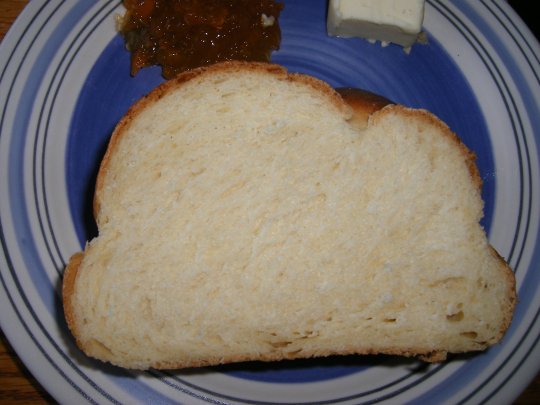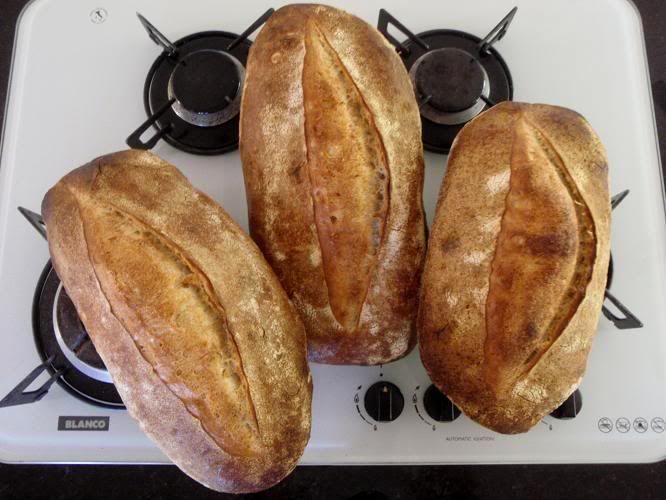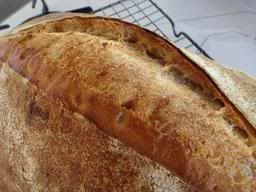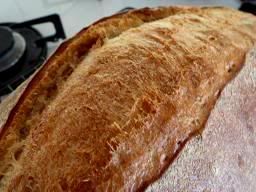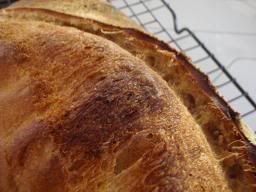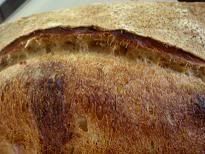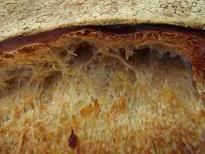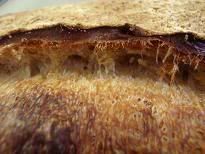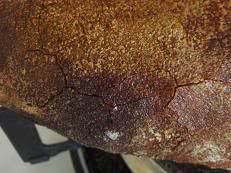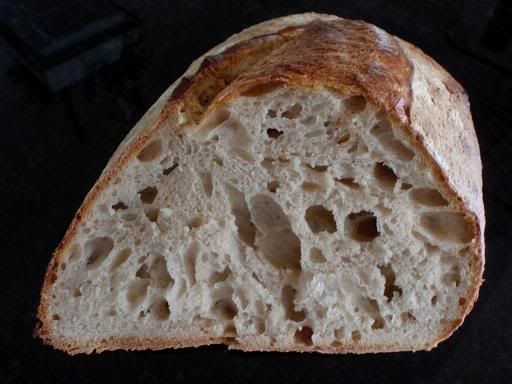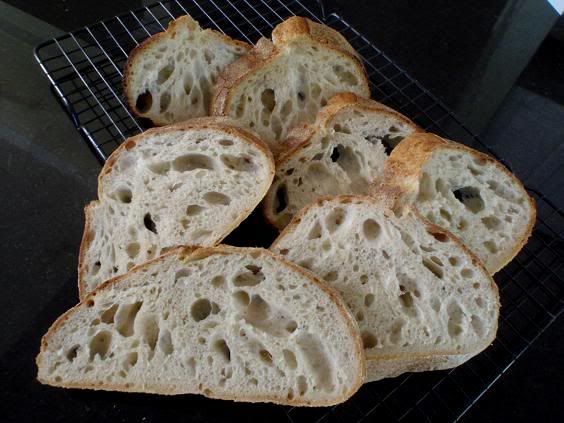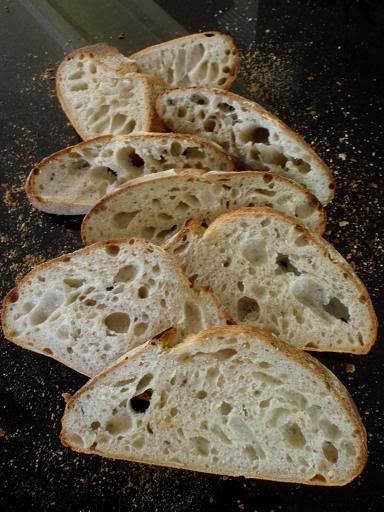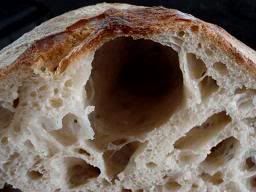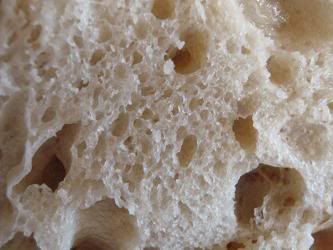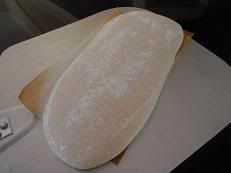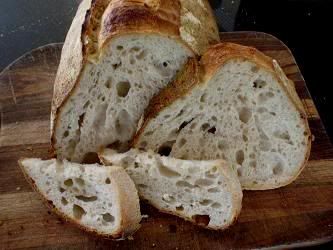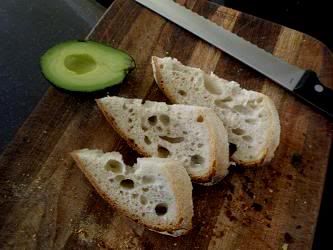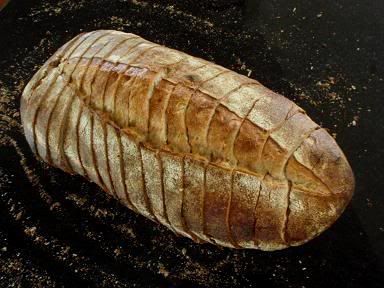Today's sourdough bread is a continuation of the experiment from last week with my modified steaming method of pouring hot water over pre-heated lava rocks in a cast iron skillet both before and after loading the loaves in the oven.
I had two new goals: In addition to trying to replicate last weeks good results, I wanted to increase the sourness of the bread and I wanted to see if I could get a “crackly” crust.
In the interest of increased sourness, I elaborated a firmer levain than what I customarily use. I fed the levain two days before mixing the dough, fermented it overnight and then refrigerated it for 18 hours. I also doubled the percentage of the levain in the formula.
I have read that lower protein flour will produce a more crackly crust, while higher protein flour produces a more crunchy, harder crust. Therefore, I used AP flour (11.7% protein) rather than the high-gluten flour (14.2% protein) I had used last week.
Since I was using a lower protein flour, I reduced the hydration of the dough to 70%. Note that the effective hydration is even a bit lower, since the levain was less hydrated also. I used the same procedures as last week except I baked the loaves slightly longer, since they were slightly larger (because of the additional levain).

|
Ingredients
|
Amount
|
Baker's percentage
|
|
Giusto's Baker's Choice flour
|
450 gms
|
90
|
|
Whole rye flour
|
50 gms
|
10
|
|
Water
|
350 gms
|
70
|
|
Salt
|
10 gms
|
2
|
|
Levain (50% hydration)
|
200 gms
|
40
|
|
Total
|
972 gms
|
212
|
Procedures
-
Mix the flours and water to a shaggy mass. Cover and let rest for 20-60 minutes.
-
Add the salt and levain and mix to moderate gluten development.
-
Transfer to the bench and do a couple of folds, then transfer the dough to an oiled bowl and cover it. Note the volume the dough will achieve when doubled.
-
After 45 minutes, do another stretch and fold, then allow the dough to double in volume.
-
Divide the dough into two equal pieces and pre-shape into rounds. Let the pieces rest, covered, for 10-20 minutes.
-
Shape each piece into a boule and transfer to well-floured bannetons, seam side up. Place each in a food-grade plastic bag, seal the openings.
-
Allow to proof for 30-60 minutes (less in a warmer environment), then refrigerate for 8-14 hours.
-
Remove the loaves from the refrigerator 2-4 hours before baking (depending on how risen they are and how warm the room is). Allow to warm up and expand to 1.5 times the loaves original volume.
-
45-60 minutes before baking, pre-heat the oven to 500F with a baking stone on the middle shelf and a cast iron skillet filled with lava rocks on the bottom shelf. (I suggest moving the stone ove to within one inch of the oven wall on your non-dominant side. Place the skillet next to the wall on your dominant side.)
-
When the loaves are ready to bake, pour 1/3 cup of boiling water over the lava rocks and close the oven door fast. (Strongly suggest holding the kettle wearing an oven mitt!)
-
Transfer the loaves to a peel or to parchment paper on a peel, and load them onto your baking stone.
-
Immediately pour ½ cup of boiling water over the lava stones and quickly close the oven door.
-
Turn the oven temperature down to 460F and set a timer for 12 minutes.
-
After 12 minutes, remove the skillet. Reset the timer for 20 minutes.
-
The loaves are done when nicely colored, thumping their bottoms gives a “hollow” sound and their internal temperature is at least 205F.
-
When the loaves are done, turn off the oven but leave the loaves in the oven with the door ajar for 7-10 minutes to dry the crust.
-
Cool thoroughly (2 hours) before slicing and serving.
Comments:
I autolysed the flours and water for about 30 minutes. I then added the levain and salt and mixed with the paddle in my KitchenAid for about 2 minutes. As I was switching to the dough hook, I was surprised how much gluten development had already occurred. I mixed with dough with the dough hook at Speed 2 for just a couple minutes more and already had moderate gluten development.
To what could I attribute this? The only possibilities were the increased percentage of levain and the different flour. My hypothesis is it was mostly the flour. We hear that higher-gluten flours require more mixing to develop the gluten. I was using a lower gluten flour than usual for this type of bread.
The dough consistency (Thank you, MC for this useful distinction from the SFBI!) was almost identical to that of last week's dough, so my guesstimated hydration adjustment seemed spot on.
These boules were proofed for a bit over an hour before they were refrigerated. The next morning, they sat at room temperature for about 2 hours before baking. When I transferred them to the peel, they spread some. This could be because of the lower gluten flour effects, slight over-proofing or a combination of factors.
The loaves had reasonable but not great oven spring, and they had less bloom than the previous bake. This suggests they were probably over-proofed a bit. I baked them for 22 minutes at 460F. They then sat in the turned off oven for 7 minutes to dry the crust.
The crust was not as shiny as the last ones, but by no means “dull.” They were singing already when I took them out of the oven. It seemed to me, that the “tune” was higher pitched than the song my boules generally sing. Could this be because of the lower gluten flour? Thinner crust? And … Woohoo! Cracks began to appear in the crust as the bread cooled!

The crust has a crunchy bite. As can be seen from the crumb shot, below, it is relatively thick. I think that, to get a thin crackly crust like a classic baguette, one must have a shorter bake at a lower temperature.
The crumb appearance was typical for my sourdoughs of this type. However, it was chewier than I expected. Very nice. The flavor was indeed more sour than last week's sourdough, as expected. I would still categorize it as mild to moderate sourness. It is not as sour as the "San Francisco Sourdough" in Reinhart's "Crust and Crumb," which uses an extremely firm levain in even higher proportions.

Conclusions:
- Increased sour flavor with firmer levain and increased levain percentage: As expected, this loaf was more sour but not dramatically so. To get a super-sour flavor, the techniques used must be pushed further.
- Crackled crust with lower protein flour: Today's bake seems to support this hypothesis. Is this effect desirable? That's a matter of taste, but, for me, it's at least nice to know how to get the effect when I want it.
- The benefits of the double steaming technique: Today's results were certainly satisfactory, but they also demonstrate that steaming is just one among several variables that contribute to oven spring and bloom.
David
Submitted to Yeast Spotting















